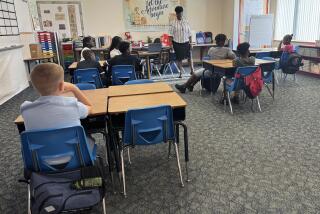Less Crowded Schools May Mean Shake-Up : Education: School administrators, teachers and parents come up with some tough choices for relieving the crunch in Southeast San Diego.
- Share via
A series of complex, wide-ranging proposals unveiled Tuesday by teachers and community residents to solve severe crowding in Southeast San Diego schools could require major changes in policies concerning integration, grade configurations and year-round schools.
Other ramifications could be enrollment caps, forced busing and deficits.
The recommendations, the result of months of meetings among school administrators, teachers and parents, address the crowding that now plagues many schools in a wide swath of San Diego from downtown to its southeast boundaries, and anchored by three high schools: San Diego, Morse and Lincoln.
Trustees of the San Diego Unified School District, the nation’s eighth-largest, spent almost three hours getting details from the community committees and raising questions and concerns that Supt. Tom Payzant will respond to later this month.
But both the five-member board and Payzant left no doubt that attempts to solve the crowding in the many predominantly minority schools would affect almost every major district policy.
For example:
- Parents and teachers in the Morse and San Diego high school clusters want to change elementary schools to kindergarten through fifth grades, junior highs to sixth through eighth grades, and high schools to ninth through 12th grades because, nationally, educators believe that such a configuration promotes better social and academic learning. But the change would require classroom construction at Morse and San Diego High schools at an estimated cost of more than $11 million. Trustees first would have to balance the financial costs with educational benefits, then try to find the money.
- Parents at venerable Lincoln High, the city’s smallest in enrollment but long a symbol of pride for the black community, want changes in attendance boundaries to steer more students there, and away from Crawford and Morse highs. But they also talked about making changes in the district’s voluntary integration plan to hold down the number of black students in Southeast San Diego who are bused to predominantly white schools in the city’s northern tier. Now, almost as many students are bused out of the Lincoln area as attend the school. Any restrictions, however, could open the district to sanctions by court officials who continue to monitor the voluntary integration plan.
- As a short-term solution, parents and teachers at Balboa, Sherman, Brooklyn and King elementaries, which are over capacity despite being on multitrack year-round schedules, want the district to bus their fifth- and sixth-graders to closed school sites elsewhere in the city beginning next summer--sites such as MacDowell Elementary west of Interstate 805 in Clairemont. But trustee Shirley Weber said the proposal raises the specter of “forced busing,” since parents would have no alternative but to move to another school area if they did not want their children to ride buses. Further, trustees would have to decide whether the reopened sites would serve only as annexes for the four crowded schools or would be open to neighborhood students as well, in effect creating new mini-schools.
- Balboa parents want the district to provide free buses so their children can safely attend nearby Memorial Junior High as seventh-graders. Although Memorial is the closest junior high for these students, the area through which they must walk is deemed so dangerous because of drug dealing and gang activity that most students choose to be bused to northern-tier schools as part of district integration. Free busing to Memorial would set a costly precedent of providing transportation to neighborhood schools, because board President Kay Davis said that each classroom of students bused to a school costs $33,000 annually.
- Long-range suggestions to build at least two elementary schools--one near Balboa and one near Sherman at a total cost of $22 million--would force the district to revamp its capital spending plans to make those schools a much higher priority. Trustees went out of their way Tuesday to caution community representatives that new schools should not be expected for at least five years, given existing shortages of money for curriculum and crowded schools in other parts of the city, such as University Heights and East San Diego.
More to Read
Sign up for Essential California
The most important California stories and recommendations in your inbox every morning.
You may occasionally receive promotional content from the Los Angeles Times.










